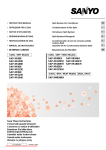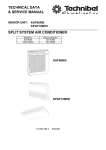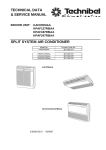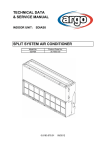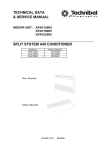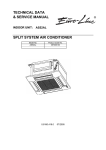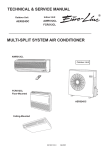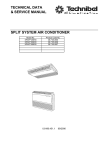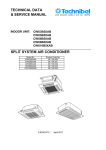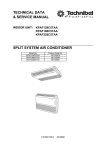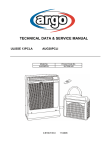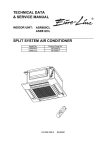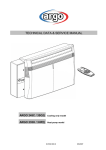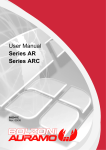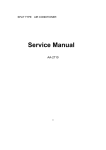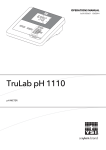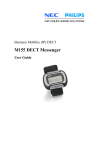Download TECHNICAL DATA & SERVICE MANUAL SPLIT
Transcript
TECHNICAL DATA & SERVICE MANUAL INDOOR UNIT: SAP- FR99EH SAP- FTR129EH SPLIT SYSTEM AIR CONDITIONER Model No. SAP- FR99EH SAP- FTR129EH Product Code No. 1 85208179 1 85208181 SAP- FR99EH Floor Mounted SAP- FTR129EH Ceiling Mounted 0.8180.279.0 07/2002 SM940013 • Ground the unit following local electrical codes. • The Yellow/Green wire cannot be used for any connection different from the ground connection. • Connect all wiring tightly. Loose wiring may cause overheating at connection points and a possible fire hazard. • Do not allow wiring to touch the refrigerant tubing, compressor, or any moving parts of the fan. • Do not use multi-core cable when wiring the power supply and control lines. Use separate cables for each type of line. IMPORTANT! Please read before installation This air conditioning system meets strict safety and operating standards. For the installer or service person, it is important to install or service the system so that it operates safely and efficiently. For safe installation and trouble-free operation, you must: • Carefully read this instruction booklet before beginning. • Follow each installation or repair step exactly as shown. • Observe all local, state and national electrical codes. • Pay close attention to all warning and caution notices given in this manual. •The unit must be supplied with a dedicated electrical line. When transporting Be careful when picking up and moving the indoor and outdoor units. Get a partner to help, and bend your knees when lifting to reduce strain on your back. Sharp edges or thin aluminium fins on the air conditioner can cut your fingers. WARNING When installing... ... In a ceiling or wall Make sure the ceiling/wall is strong enough to hold the unit-weight. It may be necessary to build a strong wooden or metal frame to provide added support. This symbol refers to a hazard or unsafe practice which can result in severe personal injury or death. ... In a room Properly insulate any tubing run inside a room to prevent "sweating", which can cause dripping and water damage to walls and floors. CAUTION This symbol refers to a hazard or unsafe practice which can result in personal injury or product or property damage. ... In moist or uneven locations Use a raised concrete base to provide a solid level foundation for the outdoor unit. This prevents damage and abnormal vibrations. If necessary, get help These instructions are all you need for most installation sites and maintenance conditions. If you require help for a special problem, contact our sale/service outlet or your certified dealer for additional instructions. ... In area with strong winds Securely anchor the outdoor unit down with bolts and a metal frame. Provide a suitable air baffle. In case of improper installation The manufacturer shall in no way be responsible for improper installation or maintenance service, including failure to follow the instructions in this document. ... In a snowy area (for heat pump-type systems) Install the outdoor unit on a raised platform that is higher than drifting snow. Provide snow vents. SPECIAL PRECAUTIONS When connecting refrigerant tubing • Keep all tubing runs as short as possible. • Use the flare method for connecting tubing. • Apply refrigerant lubricant to the matching surfaces of the flare and union tubes before connecting them; screw by hand and then tighten the nut with a torque wrench for a leak-free connection. • Check carefully for leaks before starting the test run. • During installation, connect before the refrigerant system and then the wiring one; proceed in the reverse orden when removing the units. WARNING When wiring ELECTRICAL SHOCK CAN CAUSE SEVERE PERSONAL INJURY OR DEATH. ONLY A QUALIFIED, EXPERIENCED ELECTRICIANS SHOULD ATTEMPT TO WIRE THIS SYSTEM. NOTE: Depending on the system type, liquid and gas lines may be either narrow or wide. Therefore, to avoid confusion, the refrigerant tubing for your particular model is specified as narrow tube for liquid, wide tube for gas. • Do not supply power to the unit until all wiring and tubing are completed or reconnected and checked, to ensure the grounding. • Highly dangerous electrical voltages are used in this system. Carefully refer to the wiring diagram and these instructions when wiring. Improper connections and inadequate grounding can cause accidental injury and death. When servicing • Turn the power OFF at the main power board before opening the unit to check or repair electrical parts and wiring. • Keep your fingers and clothing away from any moving parts. • Clean up the site after the work, remembering to check that no metal scraps or bits of wiring have been left inside the unit being serviced. • Ventilate the room during the installation or testng the refrigeration system; make sure that, after the installation, no gas leaks are present, because this could produce toxic gas and dangerous if in contact with flames or heat-sources. 2 Table of Contents Page 4 4 6 8 1. SPECIFICATIONS 1-1 Unit specifications 1-2 Major Component specifications 1-3 Other Component specifications 9 2. DIMENSIONAL DATA 11 11 3. PERFORMANCE DATA 3-1 Air Throw Distance Chart 13 13 4. ELECTRICAL DATA 4-1 Electric Wiring Diagrams 5. FUNCTION 5-1 Room Temperature Control 5-2 Dry Operation (Dehumidification) 5-3 Automatic Switching between Cooling and Heating 5-4 Freeze Prevention (Cooling and Dry) 5-5 Compressor Overcurrent Protection (Cooling, Dry and Heating) 5-6 Overload Prevention (Heating) 5-7 Cold Draft Prevention (Heating) 5-8 Defrosting Operation (Heating) 6. TROUBLESHOOTING 6-1 Check before and after troubleshooting 6-2 Air conditioner does not operate 6-3 Some part of air conditioner does not operate 6-4 Air conditioner operates, but abnormalities are observed 6-5 If a sensor is defective 7. CHECKING ELECTRICAL COMPONENTS 7-1 Measurement of Insulation Resistance 7-2 Checking Continuity of Fuse on PCB Ass'y 7-3 Checking Motor Capacitor 8. MAINTENANCE 8-1 Changing Address of Remote Control Unit in Indoor Unit 3 14 14 16 16 17 17 18 19 20 22 22 23 27 29 31 32 32 33 33 34 34 1. SPECIFICATIONS 1-1 Unit Specifications SAP- FR99EH Power source 220 - 240 V ~ 50 Hz Voltage rating 230 V Performance Capacity Air circulation High Features Controls/Temperature controls Control unit Timer Fan speed Airflow direction Air Filter Operation Sound Refrigerant tubing connections Refrigerant tube diameter Refrigerant Refrigerant tube kit / Air clean filter Dimensions & Weight Unit dimensions Package dimensions Weight High Narrow tube Wide tube m³/h Cooling Heating See catalogue with the requested matching 400 Microprocessor/ I.C. thermostat Wireless remote control unit ON/OFF 24 hours & Daily program, 1-hour OFF 3 and Auto /1(Hi) Manual Horizontal Manual Vertical Washable, Anti-Mold dB(A) 51 Flare type 6,35 (1/4) mm(in.) 9,52 (3/8) mm(in.) R22 or R407C Optional / Optional 700 mm 560 mm 200 mm 770 mm 620 mm 265 mm 18 kg 20 kg 0,13 m3 DATA SUBJECT TO CHANGE WITHOUT NOTICE Height Width Depth Height Width Depth Net Shipping Shipping volume 4 SAP- FTR129EH Power source 220 - 240 V ~ 50 Hz Voltage rating 230 V Performance Capacity Air circulation High Features Controls/Temperature controls Control unit Timer Fan speed Airflow direction Air Filter Operation Sound Refrigerant tubing connections Refrigerant tube diameter Refrigerant Refrigerant tube kit / Air clean filter Dimensions & Weight Unit dimensions Package dimensions Weight High Narrow tube Wide tube m³/h Cooling Heating See catalogue with the requested matching 700 Microprocessor/ I.C. thermostat Wireless remote control unit ON/OFF 24 hours & Daily program, 1-hour OFF 3 and Auto /1(Hi) Manual Horizontal Auto Vertical Washable, Anti-Mold dB(A) 55 Flare type 6,35 (1/4) mm(in.) 12,7 (1/2) mm(in.) R22 or R407C Optional / Optional 680 mm 900 mm 190 mm 770 mm 995 mm 280 mm 23,5 kg 31,5 kg 0,21 m3 DATA SUBJECT TO CHANGE WITHOUT NOTICE Height Width Depth Height Width Depth Net Shipping Shipping volume 5 1-2 Major Component Specifications SAP- FR99EH Controller PCB Part No. Controls Control circuit fuse XR99EH-(SA) Microprocessor 250 V - 3,15 A Remote Control Unit RCS-6HPS4E-G Fan & Fan Motor Type Q'ty ……. Dia. and lenght Fan motor model…Q'ty No. of poles…rpm (230 V, High) Nominal output Running Amps Power input Coil resistance (Ambient temp. 25 °C ) Safety devices mm W A W Ω Type Operating temp. Open Close °C Run capacitor µF VAC Heat Exch. Coil Coil Rows Fin pitch Face area Cross - flow 1…. Ø 100 / L 410 K35406-M01892…1 4…1196 27 0,12 26 GRY-WHT: 545÷630 WHT-VLT: 92÷105 VLT-YEL: 62÷71 GRY-BRN: 78÷90 Thermal protection 150 ± 10 Automatic 1 450 Aluminium plate fin / Copper tube 1 1,4 mm 0,185 m² DATA SUBJECT TO CHANGE WITHOUT NOTICE 6 SAP- FTR129EH Controller PCB Part No. Controls Control circuit fuse XR129EH-(SA) Microprocessor 250 V - 3,15 A Remote Control Unit RCS-6HPS4E-G Fan & Fan Motor Type Q'ty ……. Dia. and lenght Fan motor model…Q'ty No. of poles…rpm (230 V, High) Nominal output Running Amps Power input Coil resistance (Ambient temp. 25 °C ) Safety devices mm W A W Ω Type Operating temp. Open Close °C Run capacitor µF VAC Flap Motor Type Model Rating No. of poles…rpm Nominal output Coil resistance (Ambient temp. 25 °C ) W κΩ Heat Exch. Coil Coil Rows Fin pitch Face area Cross - flow 2…. Ø 130 / L 180 K48407-M01596…1 4…1160 21 0,29 65 GRY-WHT: 298÷343 WHT-PNK: 421÷485 WHT-VLT: 93,5÷108 VLT-ORG: 93,5÷108 ORG-YEL: 211÷243 Thermal protection 145 ± 5 Automatic 1.5 440 Synchro motor M2LJ24ZE31 AC 208/230 V ; 50-60 Hz 8…2,5÷3 2,5÷3 16,45±15% Aluminium plate fin / Copper tube 2 1,8 mm 0,192 DATA SUBJECT TO CHANGE WITHOUT NOTICE 7 1-3 Other Component Specifications Trasformer (TR) Rating Coil resistance SAP- FR99EH SAP- FTR129EH ATR-J105 AC 230 V ; 50-60 Hz 19 V ; 0.526 A 10 VA Primary (WHT-WHT): 205 ± 10% Secondary (BRN-BRN): 2 ± 10% 150°C Primary Secondary Capacity Ω (at 21°C) Thermal cut-off temp. Thermistor ( Coil sensor TH1) Resistance κΩ PCB-41E-S14 0 °C: 15,0 ± 5% Thermistor ( Room sensor TH2) Resistance κΩ KTEC-35-S6 25 °C: 5,0 ± 4% 8 2. DIMENSIONAL DATA SAP- FR99EH Unit: mm 9 SAP- FTR129EH Unit: mm Unit: mm 10 3. PERFORMANCE DATA 3-1 Air Throw Distance Chart SAP- FTR129EH Floor mounted Cooling Axis air velocity (m/s) Vertical distance (m) Room air temp. : Fan speed : 27°C High 3 2 Axis air velocity 1 Flap angle 60° 0 45° 0 1 2 3 4 5 6 7 Horizontal distance (m) Heating Axis air velocity (m/s) Vertical distance (m) Room air temp. : Fan speed : 20°C High 3 2 Axis air velocity 1 Flap angle 0° 0 –20° 0 1 2 3 4 5 6 7 Horizontal distance (m) 11 SAP- FTR129EH Ceiling mounted Cooling Room air temp. : Fan speed : Axis air velocity (m/s) Vertical distance (m) 0 0 1 27°C High 2 3 Horizontal distance (m) 4 5 6 7 Axis air velocity 1 Flap angle 2 30° 3 45° Heating Room air temp. : Fan speed : Axis air velocity (m/s) Vertical distance (m) 0 0 1 20°C High 2 3 Horizontal distance (m) 4 5 6 7 Axis air velocity 1 Flap angle 2 3 60° 80° 12 4. ELECTRICAL DATA 4-1 Electric Wiring Diagrams SAP- FR99EH SAP- FTR129EH 13 5. FUNCTION 5-1. Room Temperature Control ■ Cooling ● Room temperature control is obtained by cycling the compressor ON and OFF under control of the room temperature sensor in the remote control unit. ● The room temperature (and other information) is transmitted every 5 minutes by the remote control unit to the controller in the indoor unit. Signal from remote control unit 5 minutes set temp. 5 minutes 5 minutes 5 minutes 5 minutes 5 minutes 5 minutes Thermo. OFF Thermo. ON Thermo. OFF Thermo. ON Thermo. ON Thermo. ON Thermo. OFF T+1 °C T °C More than 5 minutes Compressor ON OFF 5 minutes 3 minutes ON OFF 3 seconds Outdoor fan Indoor fan ON OFF Room temp. ON OFF 3 seconds ON OFF ON OFF Set speed ● The control circuit will not attempt to turn the compressor ON until the compressor has been OFF for at least 3 minutes. To protect the compressor from stalling out when trying to start against the high side refrigerant pressure, the control circuit has a built-in automatic time delay to allow the internal pressure to equalize. ● As a protective measure, the control circuit switches the compressor OFF after 5 minutes or more of compressor operation. ● Thermo. ON : When the room temperature is above T + 1°C (T°C is set temperature). Compressor ➞ ON ● Thermo. OFF : When the room temperature is equal to or below set temperature T°C. Compressor ➞ OFF 14 ■ Heating ● Room temperature control is obtained by cycling the compressor ON and OFF under control of the room temperature sensor in the remote control unit. ● The room temperature (and other information) is transmitted every 5 minutes by the remote control unit to the controller in the indoor unit. Signal from remote control unit More than 5 minutes set temp. 5 minutes 5 minutes Thermo. ON Thermo. OFF 5 minutes 5 minutes 5 minutes 5 minutes Thermo. OFF Thermo. ON T °C T–1° C T–2 ° C 5 minutes Compressor OFF ON 5 minutes Room temp. OFF 3 seconds Outdoor fan OFF ON ON OFF ON OFF 3 seconds OFF 30 seconds Indoor fan Set speed OFF 30 seconds LL Set speed LL OFF ON *1 Standby lamp OFF ON OFF ON Indoor heat exch. coil temp. Tc ° C *1 Solenoid coil (4 – way valve) OFF Operation button OFF ON ( Reversing cycle ) ON ● The control circuit will not attempt to turn the compressor ON until the compressor has been OFF for at least 5 minutes. To protect the compressor from stalling out when trying to start against the high side refrigerant pressure, the control circuit has a built-in automatic time delay to allow the internal pressure to equalize. ● As a protective measure, the control circuit switches the compressor OFF after 5 minutes or more of compressor operation. ● Thermo. ON : When the room temperature is below T – 1°C (T°C is set temperature). Compressor ➞ ON ● Thermo. OFF : When the room temperature is equal to or above set temperature T°C. Compressor ➞ OFF NOTE *1: Refer to "5-7 Cold Draft Prevention". 15 5-2. Dry Operation (Dehumidification) ● Dry operation uses the ability of the cooling cycle to remove moisture from the air, but by running at low level to dehumidify without greatly reducing the room temperature. The air conditioner repeats the cycle of turning ON and OFF automatically as shown in the chart below according to the room temperature. Room temp. Cooling operation T+2 °C Set temp. T °C T–1 °C *Dry A zone Compressor : Continuous operation FMI (indoor fan) : L (low speed) / LL (very low speed) intermittent ventilation only while the compressor is ON. *Dry B zone Compressor : Intermittent operation (ON for 3 minutes and OFF for 9 minutes) FMI (indoor fan) : L (low speed) / LL (very low speed) intermittent ventilation only while the compressor is ON. Room temp. 15 °C Monitor zone Both the indoor and outdoor units stop. NOTE ● Intermittent ventilation occurs by switching the indoor fan speed between L ↔ LL. ● Dry operation does not occur when the room temperature is under 15°C, which is the monitor zone. ● When the compressor stops, the indoor fan stops as well. 5-3. Automatic Switching between Cooling and Heating ● When AUTO mode is selected, the microprocessor calculates the difference between the set temperature and the room temperature, and automatically switches to COOLING or HEATING mode to maintain the desired temperature. Room temp. ≥ Set temp. ➞ COOL Room temp. < Set temp. ➞ HEAT This means that if the room temperature is higher than or equal to the set temperature, COOLING operation begins. If the room temperature is lower than the set temperature, HEATING operation begins. 16 5-4. Freeze Prevention (Cooling and Dry) ● This function prevents freezing of the indoor heat exchange coil. ● When the compressor has been running for 6 minutes or more and the temperature of the indoor heat exchange coil falls below 2.4°C, the control circuit stops the compressor for at least 6 minutes. The compressor does not start again until the temperature rises above 8°C or 6 minutes has elapsed. Thermo. OFF Thermo. ON Room temp. T+1 ° C Set temp. T ° C Indoor heat exch. coil temp. More than 6 minutes 6 minutes 2.4 ° C More than 6 minutes Compressor ON More than 6 minutes OFF ON OFF ON Set speed Indoor fan ON Set speed 5-5. Compressor Overcurrent Protection (Cooling, Dry and Heating) ● This function prevents the compressor from being damaged by overcurrent. ● When the compressor current exceeds either H1(A) for 2 seconds or H2(A) for 8 seconds, both compressor and outdoor fan stop (Trip). At the same time, operation lamp in front of the indoor unit flashes. ● After 3 minutes, this function automatically releases and resumes operation until tripping repeats 8 times. If the tripping repeats 9 times or more, the unit stops its operation. 2 sec. Trip H1 (A) Compressor current (A) Trip Trip H2 (A) 6 sec. 8 sec. 7 sec. 1 sec. NOTE The compressor current shown as H1 and H2 in the chart differ by models. H1 H2 9000 BTU/h 16 A 7A 12000 BTU/h 22 A 10 A 17 5-6. Overload Prevention (Heating) ● Overload prevention prevents overheating of the indoor heat exchange coil. This function works either when the temperature of indoor heat exchange coil goes up or compressor current rises to a certain level. ■ Temperature of indoor heat exchange coil sensor ● When the temperature of the indoor heat exchange coil rises above A2°C, and if the indoor fan is L (low speed), then the fan speed changes from L (low speed) to M (medium speed). ● When the temperature of the indoor heat exchange coil rises above A1°C, the outdoor fan stops. A1 A2 Indoor heat exch. coil A3 temp. ° C A4 ON Outdoor fan Indoor fan H or M or L Compressor OFF ON H ➞ H, M ➞ M, L ➞ M ON NOTE The operation temperature shown as A1, A2, A3 and A4 in the chart differ by models. 9000 BTU/h 54°C 52°C 45°C 42°C A1 A2 A3 A4 12000 BTU/h 58°C 56°C 50°C 46°C ■ Compressor current detection ● When the compressor current rises above B1(A), and if the indoor fan is L (low speed), then the fan speed changes from L (low speed) to M (medium speed). At the same time the outdoor fan stops its operation. ● When the compressor current drops to B2(A), the outdoor fan resumes its operation. ● When the compressor current drops below B3(A), indoor fan returns to operate in set speed. Compressor B1 current (A) B2 B3 Outdoor fan Indoor fan ON H or M or L Compressor OFF ON H ➞ H, M ➞ M, L ➞ M ON NOTE The compressor current shown as B1, B2 and B3 in the chart differ by models. B1 B2 B3 9000 BTU/h 6.5 A 4.4 A 4.4 A 12000 BTU/h 9.5 A 6.5 A 6.5 A 18 5-7. Cold Draft Prevention (Heating) ● This function controls indoor fan speed so a strong draft of cold air will not blow out before the indoor heat exchange coil have sufficiently warmed up. ● STANDBY lamp on front of the indoor unit lights up when this function is working. ● Indoor fan operates in LL until indoor heat exchange coil temperature reaches 32°C. ● In case of after releasing the defrosting, indoor fan halt its operation until the coil temperature reach 32°C. ● When the coil temperature rises above Tc°C, indoor fan operates in set speed. Max. 10minutes Tc Indoor heat exch. coil temp. (°C) Indoor fan Standby lamp OFF or Set speed LL ON OFF Release of cold draft prevention NOTE The operation temperature shown as Tc in the chart differs by models. Tc 9000 BTU/h 33°C 12000 BTU/h 34°C 19 5-8. Defrosting Operation (Heating) - Reverse-cycle Defrosting Defrosting Sequence Heating Operation - compressor 4-way valve ON ON Frost Detection Frosting is assumed mostly under the following condition - indoor heat exchanger coil temperature drops 0,8°c per 6 minutes and it repeats 3 times in succession integrated operating time of compressor is longer than 3 hours temperature of indoor heat exchanger coil, immediately before thermo goes off, is below Td+5,6°C, etc NOTE: The values shown as Td differs according to the models 9000 BTU/h 38°C Td 12000 BTU/h 44°C Reverse-cycle defrosting operation - compressor outdoor fan 4-way valve indoor fan ON OFF OFF cold draft prevention mode Releasing of defrosting - Defrosting operation lasts 8 to 12 minutes (max) compressor current during reverse-cycle defrosting operation exceeds certain ampere 20 ■ Defrosting Mode Timing Chart Release of defrosting Start of defrosting 60 seconds Compressor ON Outdoor fan ON Max. 8 to 12 minutes OFF ON ON 60 seconds OFF ON 4 or 8 seconds Solenoid coil (4 – way valve) Indoor fan Standby lamp ON OFF 2 seconds OFF ON OFF Set speed OFF ON ON LL ON Indoor heat exch. coil Tc° C temp. 32° C Set speed OFF * 1 Release of cold draft prevention NOTE *1: Refer to "5-7 Cold Draft Prevention". 21 6. TROUBLESHOOTING 6-1. Check before and after troubleshooting WARNING Hazardous voltage can cause ELECTRIC SHOCK or DEATH. Disconnect power or turn off circuit breaker before you start checking or servicing. 6-1-1. Check power supply wiring. ● Check that power supply wires are correctly connected to terminals L and N on the terminal plate in the indoor unit. 6-1-2. Check inter-unit wiring. ● Check that inter-unit wiring is correctly connected to the outdoor unit from the indoor unit. 6-1-3. Check power supply. ● Check that voltage is in specified range (±10% of the rating). ● Check that power is being supplied. 6-1-4. Check lead wires and connectors in indoor and outdoor units. ● Check that coating of lead wires is not damaged. ● Check that lead wires and connectors are firmly connected. ● Check that wiring is correct. 22 6-2. Air conditioner does not operate. 6-2-1. Circuit breaker trips (or fuse blows). A. When the circuit breaker is set to ON, it is tripped soon. (Resetting is not possible.) ● There is a possibility of ground fault. ● Check insulation resistance. If resistance value is 2MΩ or less, insulation is defective (“NO”). WARNING * Set circuit breaker to OFF. 1 Remove inter-unit wires from terminal plate in outdoor unit. • Measure insulation resistance of outdoor unit. NO Insulation of outdoor unit is defective. • Measure insulation resistance of electrical parts in outdoor unit. 2 Remove inter-unit wires from terminal plate in indoor unit. Then, pull the power plug out of the wall outlet • Measure insulation resistance of indoor unit. NO Insulation of indoor unit is defective. • Measure insulation resistance of electrical parts in indoor unit. 23 B. Circuit breaker trips in several minutes after turning the air conditioner on. ● There is a possibility of short circuit. • Check capacity of circuit breaker. Replace with suitable one (larger capacity). NO Capacity of circuit breaker is suitable. In case of Heating operation : • Measure resistance of 4-way valve's winding. • Measure resistance of outdoor fan motor winding. • Measure resistance of compressor motor winding. 6-2-2. Neither indoor nor outdoor unit runs. A. Power is not supplied. • Check power supply. Circuit breaker is tripped. Reset breaker. Power failure Wait for recovery or contact power company. NO Power is being supplied to the indoor unit. B. Check "OPERATION selector" switch in the indoor unit. • OPERATION selector switch is set in ON position. YES Indoor PCB Ass'y is defective. NO Set OPERATION selector switch to ON. 24 C. Check remote control unit. • Try to run with another remote control unit. OK First remote control unit is defective. • Check for residue buildup on transmitter of remote control unit. Clean transmitter. • Check for residue buildup on remote control receiver on front of indoor unit. Clean receiver. D. Check fuse on the indoor PCB Ass'y. • Check fuse on indoor PCB Ass'y for continuity. (F) If fuse has been blown, • Measure resistance of indoor and outdoor fan motor winding. (FM) OK OK • Measure resistance of compressor motor winding. (CM) • Check operation lamp to see if light is ON. Light is OFF OK • Measure resistance of primary and secondary winding of transformer. (TR) • Measure resistance of 4-way valve's winding. (PR) OK OK • Indoor PCB Ass'y is defective. • Replace the fuse. E. Check TIMER on the remote control unit. • Timer is turned ON. Check to see if ON or is displayed on remote control YES Cancel the timer mode. 25 6-2-3. Only outdoor unit does not run. A. Check setting temperature. COOL HEAT Is room temperature too low ? Is room temperature too high ? NO NO Try to lower setting temperature by temperature setting button ( button). Try to raise setting temperature by temperature setting button ( button). Outdoor unit still does not run. Outdoor unit still does not run. • Try to run using another remote control unit. • Try to run using another remote control unit. OK OK Remote control unit is defective. Remote control unit is defective. 6-2-4. Only Indoor unit does not run. • Indoor PCB Ass'y is defective. 26 6-3. Some part of air conditioner does not operate. 6-3-1. Only indoor fan does not run. • Check fan rotation. Turn fan gently once or twice by hand. • Check fan casing foreign matter on inside. Fan cannot be turned. Remove foreign matter or repair. Fan motor burnout or foreign matter in bearings. • Measure resistance of indoor fan motor winding. Repair or replace. • When fan speed is changed, does applied voltage between lead wires BRN and WHT change as well ? OK NO • Check fan motor capacitor. • PCB Ass'y is defective. 6-3-2. Only flap motor does not run. • Measure resistance of flap motor winding. 6-3-3. Only outdoor fan does not run. • Check fan rotation. Turn fan gently once or twice by hand. • Check fan casing foreign matter on inside. Fan cannot be turned. Fan motor burnout or foreign matter in bearings. • Measure resistance of outdoor fan motor winding. OK • Check fan motor capacitor. 27 Remove foreign matter or repair. Repair or replace. 6-3-4. Only compressor does not run. Overload relay is working. (Either OLR T or OLR A) • Check compressor motor capacitor. (C1) YES • Measure resistance of compressor motor winding. Temperature of compressor is abnormally high. YES YES Refrigerant gas shortage. NO • Measure Power supply voltage. The voltage is too low. No Rotor may be locked up. 28 Charge refrigerant gas (R22). 6-4. Air conditioner operates, but abnormalities are observed. 6-4-1. Operation does not switch from HEAT to COOL (or COOL to HEAT). • Remote control unit may be defective. Receiver in lamp Ass'y may be defective. • Measure resistance of 4–way valve's winding. COOL ➞ HEAT • Check voltage between terminals No. 1(+) and No. 4 at the terminal plate. (AC 220–240V) No voltage appears. • Indoor PCB Ass'y is defective. HEAT ➞ COOL • Check voltage between terminals No. 1(+) and No. 4 at the terminal plate. (0V) 29 6-4-2. Poor cooling or heating. • Check position of remote control unit. • Cool or warm air from air conditioner reaches position directly. YES Change position of remote control unit. • Wide and narrow tubes between indoor unit and outdoor unit are insulated. NO Insulate both wide and narrow tubes separately and then tape together. YES • Measure temperature of suction and discharge air of air conditioner. Temperature difference is small. Possibility of gas shortage. Charge refrigerant gas. Temperature difference between suction and discharge air is large enough (approx. 10 deg. or more). Check for clogging of air filter. Clean filter. Air filter is clogged. • Fan speed is set to LOW. YES Set fan speed to either HIGH or MEDIUM. Reduce cooling or heating load or replace the air conditioner with larger capacity. • Review cooling load estimate, if performance of air conditioner is normal. 6-4-3. Excessive cooling or heating. • Set temperature is suitable. • Remote control unit is placed where it can detect room temperature properly. Set temperature to higher or lower value using temperature setting buttons of the remote control unit. NO NO Change position of remote control unit. 30 6-5. If a sensor is defective. 6-5-1. Thermistor (TH1 or TH2) is defective. • Operation lamp on front side of indoor unit is flashing on and off. (*) YES • Indoor coil thermistor (TH1 ) or room air thermistor (TH2 ) is defective. YES • Replace the thermistor. NOTE Alarm Signal (*) Operation lamp on the front side of the indoor unit will flash on and off when either indoor coil thermistor or room air thermistor is defective. At the same time the outdoor unit will stop. Indoor unit will operate only for ventilation. 31 7. CHECKING ELECTRICAL COMPONENTS 7-1. Measurement of Insulation Resistance power plug (Local supply) ● The insulation is in good condition if the resistance exceeds 2MΩ. Ground probe 7-1-1. Power Supply Wires Insulation tester Clamp the grounding terminal of the power plug with a lead clip of the insulation resistance tester and measure the resistance by placing a probe on either of the two power terminals. (Fig. 1) NOTE The shape of the power plug may differ from that of the air conditioner which you are servicing. Fig. 1 Then, also measure the resistance between the grounding and other power terminals. (Fig. 1) Terminal plate 7-1-2. Indoor Unit Probe Clamp a metallic part of the unit with the lead clip of the insulation resistance tester and measure the resistance by placing a probe on each terminal screw where power supply lines are connected on the terminal plate. (Fig. 2) Clip Copper tube or metallic part 7-1-3. Outdoor Unit Insulation tester Fig. 2 Clamp an aluminum plate fin or copper tube with the lead clip of the insulation resistance tester and measure the resistance by placing a probe on each terminal screw on the terminal plate. (Fig. 2) Note that the ground line terminal should be skipped for the check. Probe Clip 7-1-4. Measurement of Insulation Resistance for Electrical Parts Copper tube or metallic part Disconnect the lead wires of the desired electric part from terminal plate, capacitor, etc. Similarly disconnect the connector. Then measure the insulation resistance. (Figs. 3 and 4) Insulation tester Fig. 3 From fan motor, compressor and other parts NOTE Refer to Electric Wiring Diagram. Metallic part If the probe cannot enter the poles because the hole is too narrow then use a probe with a thinner pin. Probe Clip Insulation tester Fig. 4 51 32 7-2. Checking Continuity of Fuse on PCB Ass'y Fuse ● Remove the PCB Ass’y from the electrical component box. Then pull out the fuse from the PCB Ass’y. (Fig. 5) PCB Ass’y ● Check for continuity using a multimeter as shown in Fig. 6. Fig. 5 7-3. Checking Motor Capacitor Remove the lead wires from the capacitor terminals, and then place a probe on the capacitor terminals as shown in Fig. 7. Observe the deflection of the pointer, setting the resistance measuring range of the multimeter to the maximum value. Fuse Fig. 6 The capacitor is “good” if the pointer bounces to a great extent and then gradually returns to its original position. The range of deflection and deflection time differ according to the capacity of the capacitor. Multimeter Compressor motor capacitor Fan motor capacitor Fig. 7 33 8. MAINTENANCE 8-1 Changing Address of Remote Control Unit in Indoor Unit If you are installing more than 1 indoor unit (up to 2) in the same room, it is necessary for you to assign each unit its own address, so each can be operated by its own separate remote control unit. You assign the addresses by matching the remocon address on the PCB of each indoor unit with the switch positions of its remote control unit. To change address on PCB (1) Set the switch n.2 to "off" position on the address dip switch (S01) (see detail on figure) To change address on Remote Control Unit NB.: Once changed, you cannot restore the original address (1) Remove the batteries before changing the address (2) Remove tab marked A to change the address of the remote control unit (when is removed, the address is automatically set to B) (3) After inserting the batteries, press ACL button 34 SANYO Airconditioners Europe S.r.l. Via Bisceglie, No. 76 20152 Milano, Italy



































